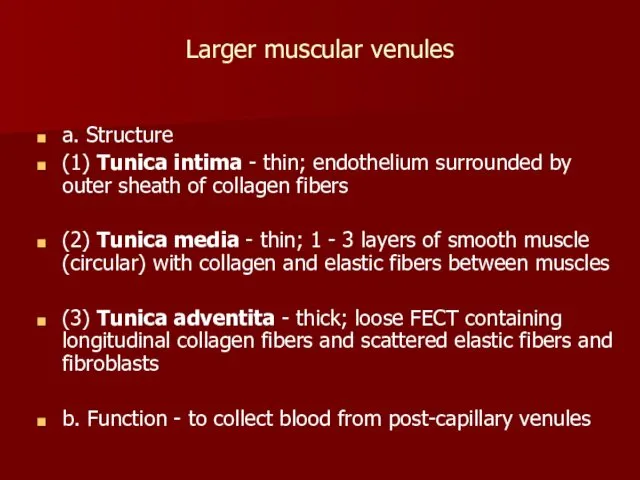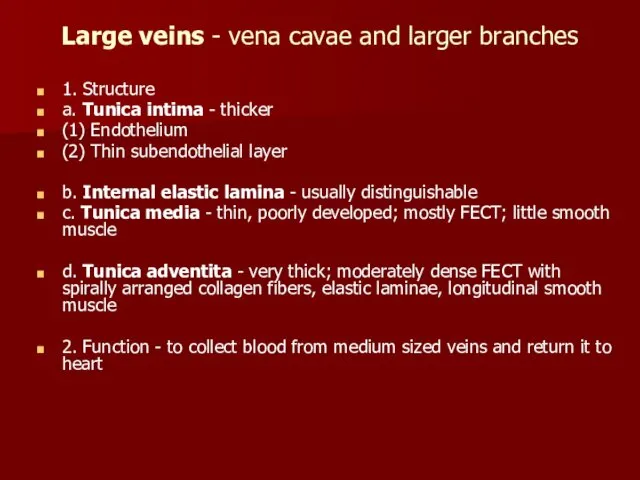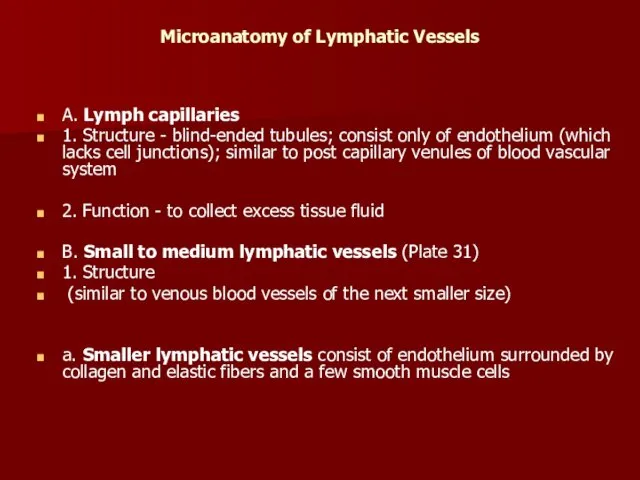- Главная
- Без категории
- Histology of the circulatory system

Содержание
- 2. 1. The heart wall can be viewed as a three-layered structure. a. Inner layer = endocardium
- 3. Structure of the heart wall 1. The endocardium is the inner layer of the heart wall
- 4. 2. The myocardium is the middle layer of the heart wall and contains the cardiac muscle
- 5. Cardiac Muscle Intercalated Disc
- 6. The epicardium is the outer layer of the heart and consists of a connective tissue region
- 7. Epicardium DFIACT Adipose Tissue Coronary vessels and cardiac nerves Mesothelium
- 8. b. A mesothelium (simple squamous epithelium) covers the outer surface of the heart (except where the
- 9. Special features of the heart 1. Valves are out growths from the endocardium which prevent backflow
- 10. "Pacemakers" in the heart are modified cardiac muscle cells. a. Cardiac muscle cells in the myocardium
- 11. The impulse-conducting system which connects the atria with the ventricles serves several functions. a. The impulse
- 12. Conduction System = AV Bundle of His + Purkinje Fibers Purkinje Fibers Muscle
- 13. Microanatomy of Blood Vessels Most larger blood vessel walls contain three major layers with sublayering. 1.
- 14. Large arteries (also called elastic arteries or conducting arteries) include the aorta and its largest main
- 15. Medium to small arteries (also called muscular arteries) Tunica intima - thin (1) Endothelium (2) Thin
- 16. Arterioles 1. Structure a. Tunica intima - very thin consisting only of endothelium b. Internal elastic
- 17. Capillaries 1. Structure - consist only of endothelium, but may be partially surrounded by pericytes. Three
- 18. Venules Size varies from 10 microns (post-capillary venules) to 1 mm (muscular venules) 2. Post-capillary venules
- 19. Larger muscular venules a. Structure (1) Tunica intima - thin; endothelium surrounded by outer sheath of
- 20. Small to medium veins 1. Structure a. Tunica intima - thin (1) Endothelium (2) Thin subendothelial
- 21. Large veins - vena cavae and larger branches 1. Structure a. Tunica intima - thicker (1)
- 22. Microanatomy of Lymphatic Vessels A. Lymph capillaries 1. Structure - blind-ended tubules; consist only of endothelium
- 23. Medium-sized lymphatic vessels b. (1) Tunica intima - thin; endothelium surrounded by few collagen and elastic
- 25. Скачать презентацию
1. The heart wall can be viewed as a three-layered structure.
a.
1. The heart wall can be viewed as a three-layered structure.
a.
b. Middle Layer = myocardium
c. Outer layer = epicardium (also called the pericardium)
2. Except for the smallest vessels, blood and lymphatic vessel walls can also be viewed as
three-layered structures.
a. Inner layer = tunica intima
b. Middle layer = tunica media
c. Outer layer = tunica adventita
Structure of the heart wall
1. The endocardium is the inner layer
Structure of the heart wall
1. The endocardium is the inner layer
lining and the underlying connective tissue layers.
a. The lumen of the heart is lined by an endothelium consisting of a typical simple
squamous epithelium with well-developed zonulae occludens and basal lamina.
b. A connective tissue region consisting of three layers separates the endothelium from
the myocardium in humans consist of:-
(1) A thin layer of loose FECT (containing mainly fine collagen fibers) referred to as subendothelial layerwhih is next to the endothelium.
(2) A thicker layer of moderately dense FECT (with many elastic fibers) and some smooth muscle forms the center of the connective tissue region.
(3) A thin layer of loose FECT (often referred to as the subendocardial layer)
containing many blood vessels joins the endocardium to the myocardium
Purkinje fibers run in this layer in the interventricular septum.
2. The myocardium
is the middle layer of the heart wall and
2. The myocardium
is the middle layer of the heart wall and
a. Cardiac muscle cells in the myocardium are arranged in strands whose ends attach to the dense connective tissue which surrounds the valves.
b. Loose FECT holds bundles of cardiac muscle cells/fibers together and contains numerous blood vessels.
c. Dense FECT (heavily collagenous) replaces the cardiac muscle in region around each of the major heart valves This connective tissue frame around each valve is called the cardiac skeleton
Cardiac Muscle
Intercalated Disc
Cardiac Muscle
Intercalated Disc
The epicardium
is the outer layer of the heart and consists of
The epicardium
is the outer layer of the heart and consists of
a. The connective tissue region consists of three layers in humans.
(1) The inner two regions are referred to collectively as the subepicardial layer and contain large blood vessels (coronary vessels), nerves, and varying amounts of adipose tissue.
(a) A thin layer of loose FECT lies next to the myocardium.
(b) A thicker layer of slightly denser FECT lies outside the loose FECT layer.
(2) A thin layer of loose FECT with many elastic fibers connects the connective tissue layers of the epicardium to the mesothelial covering.
Epicardium
DFIACT
Adipose Tissue
Coronary vessels and cardiac nerves
Mesothelium
Epicardium
DFIACT
Adipose Tissue
Coronary vessels and cardiac nerves
Mesothelium
b. A mesothelium (simple squamous epithelium) covers the outer surface of
b. A mesothelium (simple squamous epithelium) covers the outer surface of
B. The thickness of the heart wall and the thickness of the layers within the heart wall varies with location.
1. The myocardium is thickest in the ventricular region, especially the left ventricle, and contains more cardiac muscle in the ventricles than in the atrium. The myocardium around the valves contains only dense collagenous CT which forms the cardiac skeleton.
2. The endocardium and epicardium are thinner in the ventricles than in the atria
In the atria, the cardiac muscle cells contain small granules (called atrial specific granules) in the perinuclear sarcoplasm which can be observed with TEM. These granules are the source of atrial natriuretic peptide (ANP), a hormone which influences blood pressure by affecting kidney function
Special features of the heart
1. Valves are out growths from the
Special features of the heart
1. Valves are out growths from the
of blood. Valves contain three components.
.
2. The cardiac skeleton supports each of the heart valves. Cardiac
muscle in the myocardium is replaced by dense regular FECT (heavily collagenous)
3. Cardiac muscle fibers in the atria and ventricles are highly organized.
a. Cardiac muscle cells are attached end-to-end in branching strands.
b. The ends of most strands of cardiac muscle fibers are attached to the cardiac skeleton
"Pacemakers"
in the heart are modified cardiac muscle cells.
a. Cardiac muscle
"Pacemakers"
in the heart are modified cardiac muscle cells.
a. Cardiac muscle
b. Cardiac muscle cells in the atrioventricular (AV) node have a similar histological appearance, but have a lower intrinsic rate of contraction, so these cells do not normally act as a pacemaker region. These cells receive the wave of excitation from the cardiac muscle of the atria and pass the excitation on to the bundle of His.
The impulse-conducting system
which connects the atria with the ventricles serves
several functions.
a.
The impulse-conducting system
which connects the atria with the ventricles serves
several functions.
a.
(1) Purkinje fibers are organized into a branched bundle (Bundle of His) which
extends from the atrio-ventricular (AV) node, through the interventricular
septum down to the apex of the ventricles.
(2) Purkinje fibers are attached (by intercalated disks) to cardiac muscle cells in the
myocardium at the apex of the ventricles and along outer walls of both
ventricles
b. The impulse conducting system improves heart function in two ways
Conduction System =
AV Bundle of His + Purkinje Fibers
Purkinje Fibers
Muscle
Conduction System =
AV Bundle of His + Purkinje Fibers
Purkinje Fibers
Muscle
Microanatomy of Blood Vessels
Most larger blood vessel walls contain three major
Microanatomy of Blood Vessels
Most larger blood vessel walls contain three major
1. The tunica intima is the luminal layer.
a. The lumen is lined by an endothelium of simple squamous epithelium.
b. A subendothelial layer of loose FECT is present in most medium to large vessels
and may contain scattered smooth muscle in larger vessels.
2. An internal elastic lamina (elastica interna) marks the boundary between the tunica
intima and the tunica media.
3. The tunica media contains layers of either elastic laminae/lamellae (fenestrated sheets) or FECT alternating with layers of smooth muscle.
4. If present, the external elastic lamina (elastica externa) marks the boundary between
the tunica media and the tunica adventita.
5. The tunica adventita contains loose to moderately dense FECT, +/- scattered smooth
muscle cells. Small and medium arteries and veins are present in the tunica adventitia of large arteries and veins
Large arteries (also called elastic arteries or conducting arteries)
include the aorta
Large arteries (also called elastic arteries or conducting arteries)
include the aorta
(a. Tunica intima - thin (relative to other layers in this type of vessel)
(1) Endothelium
(2) Subendothelial layer contains some smooth muscle, elastic fibers, collagen fibers
b. Internal elastic lamina - not as distinct as in other arteries
c. Tunica media - thick
(1) 40 - 60 distinct, concentrically arranged elastic laminae
(2) Between elastic laminae - fibroblasts, elastic fibers, collagen fibers, spiral (to circular) smooth muscle
d. Tunica adventita - thin; consists mainly of collagen fibers, blood vessels, nerves; some elastic fibers, fibroblasts, macrophages may also be present
2. Function = to conduct blood from the heart to smaller arteries and to even out blood pressure and flow. The presence of elastic laminae gives these vessels elastic properties. They expand as the heart contracts (to modulate blood pressure and store energy) and recoil during ventricular relaxation (to maintain more even pressure in large arteries).
Medium to small arteries (also called muscular arteries)
Tunica intima - thin
(1)
Medium to small arteries (also called muscular arteries)
Tunica intima - thin
(1)
(2) Thin subendothelial layer consisting of scattered fine collagen and elastic fibers and a few fibroblasts
b. Internal elastic lamina - very distinct, usually folded
c. Tunica media - thick
(1) Circular smooth muscle, 5 - 40 layers
(2) Small amount of CT with collagen fibers and elastic fibers (longitudinal orientation) between muscle
(3) Thickness decreases as diameter of vessel decreases
d. External elastic lamina (May be indistinct in smaller muscular arteries)
e. Tunica adventita - thick; loose FECT
2. Function - to distribute blood to smaller arterial vessels. The muscular wall resists damage due to relatively high blood pressure in these vessels
Arterioles
1. Structure
a. Tunica intima - very thin consisting only of
Arterioles
1. Structure
a. Tunica intima - very thin consisting only of
b. Internal elastic lamina - usually present except in smaller arterioles
c. Tunica media - 1 to 5 layers of smooth muscle, some elastic fibers
d. Tunica adventita - thin, consisting of longitudinally arranged collagen and elastic
fibers
2. Function - to redistribute blood flow to capillaries and to alter blood pressure by altering peripheral resistance to blood flow. Arterioles can change diameter very drastically therefore affecting blood pressure and flow patterns. Arterioles are referred to as peripheral resistance vessels.
Capillaries
1. Structure - consist only of endothelium, but may be partially
Capillaries
1. Structure - consist only of endothelium, but may be partially
Three types of capillaries may be distinguished
.
a. Continuous (type I) capillaries have relatively thick cytoplasm and
the capillary wall is continuous. Lateral cell surfaces of cells are characterized by
zonula occludens (tight junctions), so materials move across cells via pinocytosis or
diffusion. These capillaries occur in most organs.
b. Fenestrated (type II) capillaries (Figure 13.18) have extremely thin cytoplasm and
the capillary wall is perforated at intervals by pores or fenestrations. Lateral cell
surfaces are characterized by zonula occludens (tight junctions). Materials
apparently cross the cells through the fenestrations. These capillaries are found in
the kidney and in endocrine glands.
c. Sinusoidal capillaries are larger in diameter than the other types and have wide
spaces between the lateral edges of the adjacent endothelial cells, so materials
(and some cells) can move freely in and out of the capillary. Sinusoidal capillaries
are found in the spleen, liver, and bone marrow.
2. Functions
a. Capillaries are the site of normal exchange of materials between blood and tissue
fluid.
b. Capillaries may be a site of exit of WBCs from blood into tissue under some conditions, although this is probably more frequent in venules.
Venules
Size varies from 10 microns (post-capillary venules) to 1 mm (muscular
Venules
Size varies from 10 microns (post-capillary venules) to 1 mm (muscular
2. Post-capillary venules
a. Structure - larger diameter than capillaries; consist of endothelium surrounded by pericytes
b. Functions
(1) Collect blood from capillaries
(2) Respond to vasoactive agents (e.g., histamine, serotonin) by altering permeability
(3) Also a site of exchange of materials between tissue fluid and blood
(4) Site of exit of WBCs from blood into tissue
Larger muscular venules
a. Structure
(1) Tunica intima - thin; endothelium surrounded by
Larger muscular venules
a. Structure
(1) Tunica intima - thin; endothelium surrounded by
(2) Tunica media - thin; 1 - 3 layers of smooth muscle (circular) with collagen and elastic fibers between muscles
(3) Tunica adventita - thick; loose FECT containing longitudinal collagen fibers and scattered elastic fibers and fibroblasts
b. Function - to collect blood from post-capillary venules
Small to medium veins
1. Structure
a. Tunica intima - thin
(1) Endothelium
(2) Thin
Small to medium veins
1. Structure
a. Tunica intima - thin
(1) Endothelium
(2) Thin
(3) May be folded to form valves
b. Tunica media - thin; circular smooth muscle, collagen fibers, some elastic fibers
c. Tunica adventita - well developed; loose FECT with longitudinally arranged collagen and elastic fibers, bundles of longitudinal smooth muscle
2. Function - to collect blood from smaller venous vessels
Large veins - vena cavae and larger branches
1. Structure
a. Tunica intima
Large veins - vena cavae and larger branches
1. Structure
a. Tunica intima
(1) Endothelium
(2) Thin subendothelial layer
b. Internal elastic lamina - usually distinguishable
c. Tunica media - thin, poorly developed; mostly FECT; little smooth muscle
d. Tunica adventita - very thick; moderately dense FECT with spirally arranged collagen fibers, elastic laminae, longitudinal smooth muscle
2. Function - to collect blood from medium sized veins and return it to heart
Microanatomy of Lymphatic Vessels
A. Lymph capillaries
1. Structure - blind-ended tubules; consist
Microanatomy of Lymphatic Vessels
A. Lymph capillaries
1. Structure - blind-ended tubules; consist
2. Function - to collect excess tissue fluid
B. Small to medium lymphatic vessels (Plate 31)
1. Structure
(similar to venous blood vessels of the next smaller size)
a. Smaller lymphatic vessels consist of endothelium surrounded by collagen and elastic fibers and a few smooth muscle cells
Medium-sized lymphatic vessels
b.
(1) Tunica intima - thin; endothelium surrounded by
Medium-sized lymphatic vessels
b.
(1) Tunica intima - thin; endothelium surrounded by
(2) Tunica media - thin; helically arranged smooth muscle, elastic fibers
(3) Tunica adventita - thicker; collagen and elastic fibers, few smooth muscle cells
2. Function - to collect lymph from lymph capillaries






















 Презентация. Десять заповедей Януша Корчака для родителей
Презентация. Десять заповедей Януша Корчака для родителей Вербальные и невербальные коммуникации
Вербальные и невербальные коммуникации Каталитикалық риформинг қондырғысының реакторлар блогы
Каталитикалық риформинг қондырғысының реакторлар блогы Общий наркоз при лечении кариеса зубов у детей
Общий наркоз при лечении кариеса зубов у детей Urban style
Urban style Разработка автоматизированной системы управления технологическим процессом получения горячей сетевой воды
Разработка автоматизированной системы управления технологическим процессом получения горячей сетевой воды Презентация Кузьма Минин - великий гражданин России.
Презентация Кузьма Минин - великий гражданин России. Родовые понятия и методологические основания социологии Эмиля Дюркгейма в цитатах
Родовые понятия и методологические основания социологии Эмиля Дюркгейма в цитатах На звездной орбите. История праздника 12 апреля
На звездной орбите. История праздника 12 апреля Цветная металлургия
Цветная металлургия Внеклассное мероприятие в начальных классах к 8 марта Милые,добрые, нежные- ВАМ!
Внеклассное мероприятие в начальных классах к 8 марта Милые,добрые, нежные- ВАМ! Формы глагола Be в настоящем простом времени. GRAMMAR
Формы глагола Be в настоящем простом времени. GRAMMAR Палеозойская эра
Палеозойская эра 20230713_05._tehnicheskoe_konstruirovanie_i_modelirovanie
20230713_05._tehnicheskoe_konstruirovanie_i_modelirovanie Режимы работы редактора Word
Режимы работы редактора Word Общая характеристика спортивной подготовки
Общая характеристика спортивной подготовки Презентация: Столица моей родины - Москва
Презентация: Столица моей родины - Москва Упражнения для развития памяти и внимания на уроках иностранного языка
Упражнения для развития памяти и внимания на уроках иностранного языка Российский университет дружбы народов Комиссия по связям с общественностью
Российский университет дружбы народов Комиссия по связям с общественностью Презентация к проекту Что в имени моем...
Презентация к проекту Что в имени моем... Внеклассные мероприятия
Внеклассные мероприятия Настоящее совершенное время Present Perfect Tense
Настоящее совершенное время Present Perfect Tense Творчество ненецкого художника К.Л.Панкова. Презентация
Творчество ненецкого художника К.Л.Панкова. Презентация Создание программы
Создание программы Коммунальная техника ЖКХ
Коммунальная техника ЖКХ Ядерный реактор как источник ионизирующего излучения. Решение задач
Ядерный реактор как источник ионизирующего излучения. Решение задач Магия намерения. Мужской и женский способ достижения желаемого
Магия намерения. Мужской и женский способ достижения желаемого Функциональные элементы САР ЭПС: исполнительные и управляющие элементы
Функциональные элементы САР ЭПС: исполнительные и управляющие элементы